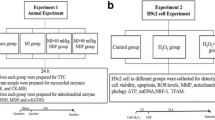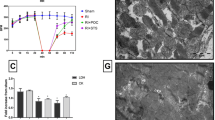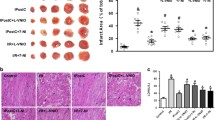Abstract
Purpose
The present study was to determine whether OP2113 could limit myocardial infarction size and the no-reflow phenomenon in a rat myocardial ischemia/reperfusion model.
Methods
Rat heart–isolated mitochondria (RHM) were used to investigate mitochondrial respiration and mitochondrial reactive oxygen species (mtROS) generation both in normal conditions and in ischemia/reperfusion-mimicking conditions (using high concentrations of succinate). Human skeletal muscle myoblasts (HSMM) in culture were used to investigate the cellular intermittent deprivation in energy substrates and oxygen as reported in ischemia/reperfusion conditions. In vivo, rats were anesthetized and subjected to 30 min of left coronary artery occlusion followed by 3 h of reperfusion. Rats were randomized to receive OP2113 as an intravenous infusion starting either 5 min prior to coronary artery occlusion (preventive), or 5 min prior to reperfusion (curative), or to receive vehicle starting 5 min prior to coronary artery occlusion. Infusions continued until the end of the study (3 h of reperfusion).
Results
RHM treated with OP2113 showed a concentration-dependent reduction of succinate-induced mtROS generation. In HSMM cells, OP2113 treatment (5–10 μM) during 48H prevented the reduction in the steady-state level of ATP measured just after reperfusion injuries and decreased the mitochondrial affinity to oxygen. In vivo, myocardial infarct size, expressed as the percentage of the ischemic risk zone, was significantly lower in the OP2113-treated preventive group (44.5 ± 2.9%) versus that in the vehicle group (57.0 ± 3.6%; p < 0.05), with a non-significant trend toward a smaller infarct size in the curative group (50.8 ± 3.9%). The area of no reflow as a percentage of the risk zone was significantly smaller in both the OP2113-treated preventive (28.8 ± 2.4%; p = 0.026 vs vehicle) and curative groups (30.1 ± 2.3%; p = 0.04 vs vehicle) compared with the vehicle group (38.9 ± 3.1%). OP2113 was not associated with any hemodynamic changes.
Conclusions
These results suggest that OP2113 is a promising mitochondrial ROS–modulating agent to reduce no-reflow as well as to reduce myocardial infarct size, especially if it is on board early in the course of the infarction. It appears to have benefit on no-reflow even when administered relatively late in the course of ischemia.





Similar content being viewed by others
References
Han H, Wei X, He Q, Yu Y, Ruan Y, Wu C, et al. Comparison of in-hospital mortality and length of stay in acute ST-segment-elevation myocardial infarction among urban teaching hospitals in China and the United States. J Am Heart Assoc. 2019;8(22):e012054.
Bahit MC, Ajar Kochar A, Granger CB. Post-myocardial infarction heart failure. JACC Heart Fail. 2018;6(3):179–86.
Detaille D, Pasdois P, Sémont A, Santos PD, Diolez P. An old medicine as a new drug to prevent mitochondrial complex I from producing oxygen radicals. PLoS One. 2019;14(5):e0216385.
Amoedo ND, Dard L, Sarlak S, Mahfouf W, Blanchard W, Rousseau B, et al. Targeting human lung adenocarcinoma with a suppressor of mitochondrial superoxide production. Antioxid Redox Signal. 2020. https://doi.org/10.1089/ars.2019.7892 Online ahead of print.
Sloan RC, Moukdar F, Frasier CR, Patel HD, Bostian PA, Lust RM, et al. Mitochondrial permeability transition in the diabetic heart: contributions of thiol redox state and mitochondrial calcium to augmented reperfusion injury. J Mol Cell Cardiol. 2012;52(5):1009–18.
Gnaiger E. Mitochondrial pathways and respiratory control. An introduction to OXPHOS analysis. 4th ed. Innsbruck: Oroboros MiPNet Publications; 2014. www.bioblast.at/index.php/Gnaiger_2014_MitoPathways
Chance B, Williams GR. Respiratory enzymes in oxidative phosphorylation. I. Kinetics of oxygen utilization. J Biol Chem. 1955;217:383–93.
Makrecka-Kuka M, Krumschnabel G, Gnaiger E. High-resolution respirometry for simultaneous measurement of oxygen and hydrogen peroxide fluxes in permeabilized cells, tissue homogenate and isolated mitochondria. Biomolecules. 2015;5:1319–38.
Alleman RJ, Tsang AM, Ryan TE, Patteson DJ, McClung JM, Spangenburg EE, et al. Exercise-induced protection against reperfusion arrhythmia involves stabilization of mitochondrial energetics. Am J Physiol Heart Circ Physiol. 2016;310(10):H1360–70.
Gnaiger E, Steinlechner-Maran R, Méndez G, Eberl T, Margreiter R. Control of mitochondrial and cellular respiration by oxygen. J Bioenerg Biomembr. 1995;27(6):583–96.
Li Y, Kloner RA. Is there a gender difference in infarct size and arrhythmias following experimental coronary occlusion and reperfusion? J Thromb Thrombolysis. 1995;2(3):221–5.
Dow JS, Bhandari A, Hale SL, Kloner RA. Does sex influence the incidence or severity of reperfusion-induced cardiac arrhythmias? Springerplus. 2015;4:96.
Gnaiger E. Oxygen conformance of cellular respiration. A perspective of mitochondrial physiology. Adv Exp Med Biol. 2003;543:39–55.
Walsh M, Devereaux PJ, Garg AX, Kurz A, Turan A, Rodseth RN, et al. Relationship between intraoperative mean arterial pressure and clinical outcomes after noncardiac surgery: toward an empirical definition of hypotension. Anesthesiology. 2013;119(3):507–15.
Kloner RA, Brown DA, Csete M, Dai W, Downey JM, Gottlieb RA, et al. New and revisited approaches to preserving the reperfused myocardium. Nat Rev Cardiol. 2017;14(11):679–93.
Kloner RA. Mitochondrial protective agents for ischemia/reperfusion injury. Circ Cardiovasc Interv. 2017;10(9):e005805.
Lesnefsky EJ, Chen Q, Tandler B, Hoppel CL. Mitochondrial dysfunction and myocardial ischemia-reperfusion: implications for novel therapies. Annu Rev Pharmacol Toxicol. 2017 Jan 6;57:535–65.
Dröse S, Stepanova A, Galkin A. Ischemic A/D transition of mitochondrial complex I and its role in ROS generation. Biochim Biophys Acta. 2016;1857(7):946–57.
Murphy MP, Hartley RC. Mitochondria as a therapeutic target for common pathologies. Nat Rev Drug Discov. 2018;17(12):865–86.
Prag HA, Gruszczyk AV, Huang MM, Beach TE, Young T, Tronci L, Nikitopoulou E, Mulvey JF, Ascione R, Hadjihambi A, Shattock MJ, Pellerin L, Saeb-Parsy K, Frezza C, James AM, Krieg T, Murphy MP, Aksentijević D. Mechanism of succinate efflux upon reperfusion of the ischemic heart. Cardiovasc Res. 2020;cvaa148. https://doi.org/10.1093/cvr/cvaa148. Online ahead of print.
Kloner RA, King KS, Harrington MG. No-reflow phenomenon in the heart and brain. Am J Physiol Heart Circ Physiol. 2018;315(3):H550–62.
Stone GW, Selker HP, Thiele H, Patel MR, Udelson JE, Ohman EM, et al. Relationship between infarct size and outcomes following primary PCI: patient-level analysis from 10 randomized trials. J Am Coll Cardiol. 2016;67(14):1674–83.
Kloner RA. No-reflow phenomenon. A new target for therapy of acute myocardial infarction independent of myocardial infarct size. J Cardiovasc Pharmacol Ther. 2018;23(3):273–6.
Kloner RA. No-reflow phenomenon: maintaining vascular integrity. J Cardiovasc Pharmacol Ther. 2011;16(3–4):244–50.
Kloner RA, Hale SL, Dai W, et al. Reduction of ischemia/reperfusion injury with bendavia, a mitochondria-targeting cytoprotective peptide. J Am Heart Assoc. 2012;1(3):e001644.
Dai W, Cheung E, Alleman RJ, Perry JB, Allen ME, Brown DA, et al. Cardioprotective effects of mitochondria-targeted peptide SBT-20 in two different models of rat ischemia/reperfusion. Cardiovasc Drugs Ther. 2016;30:559–66.
Gibson CM, Giugliano RP, Kloner RA, Bode C, Tendera M, Jánosi A, et al. EMBRACE STEMI study: a phase 2a trial to evaluate the safety, tolerability, and efficacy of intravenous elamipretide (MTP-131) on reperfusion injury in patients undergoing primary percutaneous intervention. Eur Heart J. 2016;37(16):1296–303.
Piot C, Croisille P, Staat P, Thibault H, Rioufol G, Mewton N, et al. Effect of cyclosporine on reperfusion injury in acute myocardial infarction. N Engl J Med. 2008;359(5):473–81.
Cung TT, Morel O, Cayla G, Rioufol G, Garcia-Dorado D, Angoulvant D, et al. Cyclosporine before PCI in patients with acute myocardial infarction. N Engl J Med. 2015;373(11):1021–31.
Bøtker HE, Cabrera-Fuentes HA, Ruiz-Meana M, Heusch G, Ovize M. Translational issues for mitoprotective agents as adjunct to reperfusion therapy in patients with ST-segment elevation myocardial infarction. J Cell Mol Med. 2020;24(5):2717–29.
Kloner RA. Current state of clinical translation of cardioprotective agents for acute myocardial infarction. Circ Res. 2013;113(4):451–63.
Xu Q, Ming Z, Dart AM, Du XJ. Optimizing dosage of ketamine and xylazine in murine echocardiography. Clin Exp Pharmacol Physiol. 2007;34(5–6):499–507.
Clanachan AS, McGrath JC. Effects of ketamine on the peripheral autonomic nervous system of the rat. Br J Pharmacol. 1976;58(2):247–52.
Picollo C, Serra AJ, Levy RF, Antonio EL, dos Santos L, Tucci PJF. Hemodynamic and thermoregulatory effects of xylazine-ketamine mixture persist even after the anesthetic stage in rats. Arq Bras Med Vet Zootec. 2012;64(4):860–4.
Afshar FS, Baniadam A, Marashipour SP. Effect of xylazine-ketamine on arterial blood pressure, arterial blood pH, blood gases, rectal temperature, heart and respiratory rates in goats. Bull Vet Inst Pulawy. 2005;49:481–4.
Canty JM Jr, Smith TP Jr. Modulation of coronary autoregulatory responses by endothelium-derived nitric oxide. Int J Cardiol. 1995;50(3):207–15.
Goodwill AG, Dick GM, Kiel AM, Tune JD. Regulation of coronary blood flow. Compr Physiol. 2017;7(2):321–82.
von Planta I, Weil MH, von Planta M, Bisera J, Bruno S, Gazmuri RJ, et al. Cardiopulmonary resuscitation in the rat. J Appl Physiol (1985). 1988;65(6):2641–7.
Funding
Dr. Robert A. Kloner is the principle investigator of this work, and the project was supported by OP2 Drugs, Pessac, France.
Author information
Authors and Affiliations
Contributions
The authors made substantial contributions to the conception or design of the work (R.A.K.) or to the acquisition, analysis, or interpretation of data for the work (W.D., N.D.A., J.P., B.L.G., A.B., J.C., L.Z., D.A.B., R.R., R.A.K.); participated in critically revising the manuscript (W.D., N.D.A., J.P., B.L.G., A.B., J.C., L.Z., D.A.B., R.R., R.A.K.); approved the final version to be published (W.D., N.D.A., J.P., B.L.G., A.B., J.C., L.Z., D.A.B., R.R., R.A.K.); and agreed to be accountable for all aspects of the work (W.D., N.D.A., J.P., B.L.G., A.B., J.C., L.Z., D.A.B., R.R., R.A.K.).
Corresponding author
Ethics declarations
Conflict of Interest
Aurélie Boucard and Bruno Le Grand are employees for OP2 Drugs. Rodrigue Rossignol is a scientific advisor for OP2 Drugs. There are no conflicts of interest for Drs. Dai, Amoedo, Perry, Carreno, Zhao, Brown, and Kloner.
Additional information
Publisher’s Note
Springer Nature remains neutral with regard to jurisdictional claims in published maps and institutional affiliations.
Rights and permissions
About this article
Cite this article
Dai, W., Amoedo, N.D., Perry, J. et al. Effects of OP2113 on Myocardial Infarct Size and No Reflow in a Rat Myocardial Ischemia/Reperfusion Model. Cardiovasc Drugs Ther 36, 217–227 (2022). https://doi.org/10.1007/s10557-020-07113-7
Accepted:
Published:
Issue Date:
DOI: https://doi.org/10.1007/s10557-020-07113-7




